How your recycling is sorted
Collection, sorting and recycling
- After your local council picks up your kerbside recycling bin, your recyclable materials are transported to one of two Materials Recovery Facilities (MRF’s) to be sorted.
- These are located at Bidston on the Wirral, and at Gillmoss in Liverpool.
- The Materials Recovery Facilities accept mixed dry recyclable waste, and here it is sorted by using a range of technology and mechanical separation techniques.
- There has been a steady increase in the numbers of Materials Recovery Facilities in the UK as more separate dry recyclable collections have been introduced and overall recycling tonnages have increased.
- The MRF’s employ a system of conveyors that carry the recyclables over sorting screens and other sorting mechanisms.
- These divide the different components of the dry recyclables, which pass over magnetic and eddy current separators. Advanced optical materials recognition equipment then separates out different types of materials.
- There is also an element of hand-sorting of materials in addition to the automatic extraction of materials as part of the separation process.
- After the sorting of the materials into the separate streams, there is a bulking and storage function whereby balers are used to compress some of the recyclables (cans and bottles) into dense bales for transport to the materials reprocessors.
FACTS AND FIGURES
- The Materials Recovery facility at Bidston has been open and operational since 2006. Gillmoss has been operating since 2011.
- The Bidston facility has the capacity to sort up to 80,000 tonnes of dry recyclables materials each year. The Gillmoss MRF can sort 250 tonnes every day.
- Currently the MRF’s are being used by Liverpool, Halton, Knowsley, Sefton and Wirral Councils to sort dry recyclables.
WHAT CAN THE MATERIAL RECOVERY FACILTY SORT?
- CANS AND TINS: Steel cans, aluminium cans, loose steel lids from bottles and jars. These should be rinsed out but not crushed.
- CARDBOARD: Cardboard boxes, cardboard food packaging, carboard egg cartons, toilet/kitchen rolls and greetings cards.
- GLASS: all types and colours except drinking glasses, Pyrex and window glass. Lids from jars and bottles can be kept on. Glass should not be smashed or broken.
- PAPER: Newspapers, magazines, junk mail, office paper, envelopes, paper bags, wrapping paper (Sellotape and other sticky tape should be removed), catalogues, telephone directories and Yellow Pages.
- PLASTIC BOTTLES: Plastic drinks bottles such as juice, water, milk and cordials. Shampoo bottles and household cleaner bottles such as fabric softener, washing liquid etc. Bottles should be emptied and rinsed but not flattened.
HOW THE MATERIALS RECOVERY FACILITY SORTS YOUR RECYCLING
STAGE ONE: Mixed dry recyclable materials are brought into the Facility and deposited on the MRF Reception Hall Floor
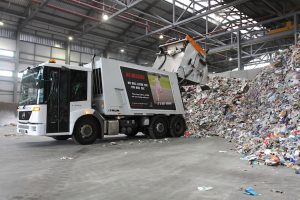
- The District Councils collect dry recyclable materials at kerbside.
- These are brought to the Facility in a separate collection to residual waste.
- The dry recyclables are deposited straight from the vehicle onto the MRF Reception Hall Floor.
- Any large or oversized contaminants are removed at this stage
STAGE TWO: The materials are fed onto the in-feed conveyor
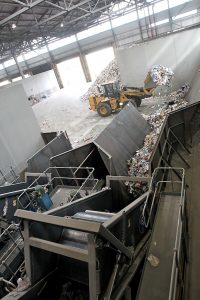
- The dry recyclable materials are then fed onto the in- feed conveyor. This will move the materials upwards to the pre-sort cabin.
STAGE THREE Materials are then sent through the pre-sort cabin
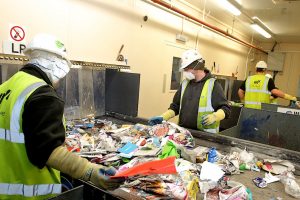
- The dry recyclable materials arrive in the enclosed pre-sort cabin.
- At this stage trained staff help the sort process by removing cardboard
- They also remove smaller items that cannot be sorted or recycled at the facility.
STAGE FOUR: The materials are then fed through the ‘V screen’
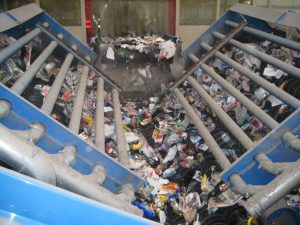
- Materials are then fed through the ‘V screen’.
- This sorting mechanism separates out the paper element of the stream over the top of the screen.
- It does this by using a system of rotating discs and compressed air.
- Paper is then diverted away for further sorting.
STAGE FIVE: The remaining materials are then sent through the ‘3D cabin’
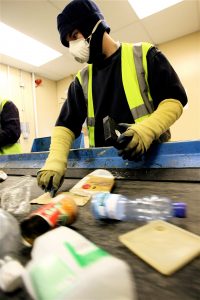
- The ‘3D cabin’ is where the remaining recyclable streams (glass, plastic and cans) are checked
- Trained staff check that no other major contaminants are left in the waste stream.
STAGE SIX: From the sorting in the ‘3D cabin’, glass is removed in separate stream.
- From the 3D cabin the remaining materials pass through the glass breaker.
- Glass is broken into small pieces which allows it to drop through spaces into a separate conveyor where it goes for final cleaning and bulking up
- The cans and plastics continue onto the next phase of the process
STAGE SEVEN: From the sorting in the ‘3D cabin’ and after glass is removed, cans are removed in a separate stream
- Steel cans are removed from remaining recyclables using an overhead magnet
- Aluminium cans are removed using an eddy current – this is like a reverse magnet
- Cans are then partly compacted and baled
STAGE EIGHT: After cans are removed, plastic bottles are removed in a separate stream
- The remaining plastic bottles are pierced and flattened and conveyed for baling
- A final check is made on any remaining materials and contaminants are removed in the post sort cabin.
STAGE NINE: The individual recyclable material streams are offloaded from and baled or compacted
- The individual streams of recyclables are then offloaded.
- Cans are compacted into bales
- Glass is bulked up in skips for removal and reprocessing
- Plastics are compacted into bales
- Paper is collected loose for transportation to the paper mill